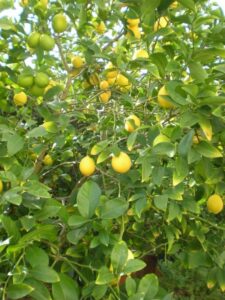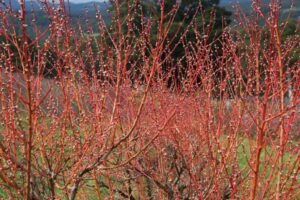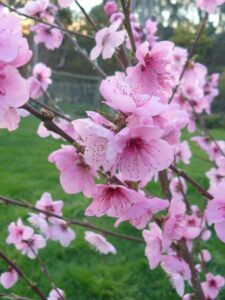
Adapting fruit trees to a changing climate
By Gabrielle Stannus
As we plan for climate change, we hear a lot about street trees planted for their ornamental and environmental amenity. What about fruit trees in these and other public landscapes and home gardens? What can we learn from commercial orchardists now to help improve how we select and maintain fruit trees to survive our changing climate, particularly those varieties that require winter chill?
Climate change will affect both evergreen and deciduous fruit trees. By 2030, winters in some of Australia’s warmer fruit-growing regions may be too mild to support apple production, whilst growers in some regions will need to adapt their orchards to cope with days of extreme summer heat or risk significant loss of fruit from sunburn damage1 . High temperature and high atmospheric CO2 levels associated with climate change will increase vegetative vigour at the expense of fruit yield in apples, and lead to apples with thinner skins more prone to damage2. The Australian fruit industry has already seen large-scale losses of young fruit trees, or seasons where fruit develops poorly, whilst lower apple, pear, cherry and nut yields are predicted as winters get warmer3. Evergreen fruit trees are also at risk from climate change. Citrus are sensitive to temperature and humidity variations, with increased temperature shown to negatively impact fruit set, reduce the potential crop and affect fruit size4.

Key adaptation tipping points for fruit trees
Research into apple varieties grown commercially shows that there are four key climate adaptation tipping points for fruit trees: 1) winter chilling, 2) spring flowering, 3) summer extreme heat, and 4) potential yield5. Projected warmer winters associated with climate change are likely to lead to insufficient winter chill and, therefore, poorer flowering and lower production in deciduous trees. Timing of flowering may shift in response to changes in temperature, which may affect frost risk and synchronisation of cross-pollinating cultivars, i.e. pollination partners. A delay in flowering is likely in many growing districts by 2050, and in most by 2090, so frost risk may be lowered in the future5. However, the complexity of predicting frost makes future projections of flowering and frost risk difficult to assess.
Different types of deciduous fruit, and even different varieties of the same fruit, require different amounts of chill to end their dormant phases 1 . Fruit trees enter a dormant phase over winter to prevent cold damage to shoots and flowers by stopping them from appearing during a winter warm spell1. Dormancy ends when the trees have received a certain amount of cold winter weather, termed ‘chill’, and not in response to warmer temperatures as might be thought. Having met their ‘chill requirement’, trees sense that winter has ended and will flower in response to warm temperatures. Many stone fruit varieties will not flower and produce fruit until the trees are exposed to temperatures lower than –7oC (45oF) for a minimum number of hours6, otherwise known as ‘chill hours’.
Select more suitable varieties with the future in mind
When trying to find out information about how future climate will affect fruit trees in the area you work in, it is important to understand how climate is being modelled. Whilst climate analogues compare different regions with similar climates, climate niches focus on the specific climate conditions required by species or ecosystems. Both methodologies have their limitations yet provide a useful starting point in guiding fruit tree selection now.

CSIRO’s climate analogue tool matches the proposed future climate of a region of interest with the current climate experienced in another region using annual average rainfall and maximum temperature (within set tolerances). The results from applying changes to annual temperature and rainfall settings in the analogues explorer, capture sites of broadly similar annual maximum temperature and water balance. For example, the future climate of Melbourne will be more like the current climate of Dubbo (NSW), based on a high-emission scenario at the end of the 21st century. What fruit trees are currently doing well in Dubbo? Could they do similarly in Melbourne in the future? Whilst climate analogues are useful in helping us imagine possible climate futures, they are only approximated. There are several factors that they do not consider, including topography, frost days, solar radiation, etc., all important considerations in plant growth.
The “Which Plant Where” tool by Macquarie University primarily uses a climate niche methodology to guide plant selection by landscape designers and horticulturists. Once you have made an initial selection by species or location, you can click on the profile of an individual species and are presented with its form, site and performance characteristics, as well as potential uses. Search results returned will show the climatic suitability of the selected species in the years 2030, 2050 and 2070. This tool is not limited to trees; you can search for many life forms. Edible species are identified in search results, however, you cannot filter use by that trait/characteristic. Another limitation of this tool is that climatic suitability data is not currently provided for cultivars and hybrids. Some experts argue that climate niche analysis lacks consideration as to the tolerance mechanisms that many tree species possess to tolerate stress, and their capacity to adapt and acclimate to changing environmental conditions7.
High tolerance to stress is vital if fruit trees and other plants are to survive in our future climate. Murdoch University scientists are working to climate-proof popular fruits including custard apples and paw paw. These scientists are exploring plants’ ability to tolerate stress through genetic testing, including whole genome sequencing and allele mining to find how vital traits are coded on a plant’s genome4. These researchers are targeting traits like drought resistance and heat tolerance in a bid to transfer them to other plants, thereby creating climate resilient cultivars that can survive higher temperatures and produce better yields. In the new and improved fruit varieties being produced by this program, scientists are seeing deeper roots, more vigorous growth and better leaf growth.
Create climate resilient cultivars
One business working to promote resilient cultivars is PlantNet, a subsidiary of the Australian Nurserymen’s Fruit Improvement Company (ANFIC). Whilst PlantNet specialises in dwarf fruit trees, especially apples and pears, its growers also produce almond, apricot, cherry, citrus, fig, nectarine, peach, pear, and subtropical fruit trees for the home gardener. The PlantNet range includes the Super Dwarf Sunset Peach and Nectarine, low-chill peach and nectarine trees suited to the warmer climates of Queensland, northern New South Wales, and Western Australia.
PlantNet Marketing Coordinator, Emma Swan believes that varietal selection is critical to safeguarding fruit trees in a climate-constrained future: “We need to understand the chill hours of fruit trees and individual varieties better. Cherries and apricots are of particular concern, especially cherries which are notoriously high chill.” Californian breeder International Fruit Genetics (IFG) is developing new low-chill (100 to 400 chill hours) cherry releases intended for regions with mild to almost non-existent winters, and that deliver clean fruit without the doubles, spurs and sutures that some cultivars develop in the heat8. Such low-chill varieties are targeted for commercial markets and are highly unlikely to be available to landscapers and horticulturists working in public landscapes and private gardens any time soon.

So how can we select fruit trees to survive in our rapidly changing climate? Emma encourages landscape architects and designers to err on the side of caution: “Add those varieties that are slightly lower chilling than what you or even your customer might want to your plant palette. For example, if your client wants a European plum, consider selecting a Japanese plum which has much lower chilling requirements. Look at the lower end of your chill hour range, particularly in urban areas where there are other things at play like heat sinks. The reality of a lot of trees is that they have different lifespans. Whilst apples and pears may live a lot longer, peaches and nectarines live hard and fast. You might opt for a higher chilling nectarine and a lower chilling apple because the apple might live for a longer time, and therefore be exposed to a hotter future climate at the end of its life.”
Chill hours guide
- Low-chill areas = up to 450 chill units*. You can only grow low-chill varieties in low-chill areas.
- Medium-chill areas = 450–650 chill units. You can generally grow all low and medium-chill fruit varieties providing low-chill plants are protected from late spring frosts.
- High-hill areas = >650 chill units. You can generally grow all low, medium and high-chill fruit varieties, providing low and medium-chill plants are protected from late spring frosts.
The following is a general guide to chill areas across Australia. Note that these areas are likely to shift with climate change.
- Tropical and sub-tropical areas will generally be low chill areas – for example, coastal areas from the east coast near Port Macquarie north to Queensland are generally sub-tropical, becoming more tropical as you move further north.
- Temperate regions are generally medium-chill areas, such as on the east coast from Port Macquarie south to Victoria. Many fruit varieties fall into this category which means most Australians living in these areas can enjoy growing peaches and nectarines in their backyard.
- Cool to cold regions are generally medium to high-chill areas. This includes the area that runs from Toowoomba to Armidale, Tamworth, Bathurst, Canberra, Shepparton, Melbourne, and Tasmania.
* Chill units are measured using a more complex calculation that accounts for the varying effectiveness of different temperature ranges on dormancy breaking. Chill units provide a more nuanced measurement compared to chill hours.
(Adapted with permission from the PlantNet Guide to Fruit Trees: https://plantnet.com.au/plant-care/chill-hours-guide/)
Knowing the current and projected annual chill hours of your area will aide in deciduous fruit tree selection now. In Tasmania, we are fortunate that we can access chill hour estimates quickly and easily on the State Government’s LISTmap. One dataset represents the recent climate to 2018 and then the projected climate in 2030 and 2050. On each of these layers, a statewide grid surface (30m spatial resolution) delineates the average amount of chill hours where temperatures fall within 0 to 7°C for the months of May to August. This was calculated by totalling the number of hours that were within the 0 – 7°C range and averaging the yearly total over a 20-year climate period9.
Calculate your winter chill
Check out the Winter Chill Calculator on the Queensland Department of Agriculture and Fisheries website. This site accesses daily weather station data for 600 locations across Australia from 1968 to the current year. This data is used to calculate the accumulation of winter chill and growing degree days/hours. You can also compare temperature/rainfall over time!
Winter Chill Calculator: http://grf-smartfarm.daf.qld.gov.au:3838/apps/chillcalculator/
If you are based in Tasmania, you can view recent and projected chill hours for your area as follows:
- Open the LISTmap in your favourite internet browser: www.thelist.tas.gov.au/listmap
- Enter your location in the search bar at the top of the screen
- Click on the ‘Layers’ tab at the top right-hand side of the screen, then click ‘Add Layer +’
- Type ‘chill’ in the ‘Search for’ field in the pop-up box that appears
- Under the search results, expand the ‘Meteorology’ tab and you will see the following layers listed (amongst others):
- A. Chill Hours
- B. Chill Hours [CFT 2030]
- C. Chill Hours [CFT 2050]
- Click on the green ‘+’ button at the righthand side of each layer name to add them to your map, and explore the projected change in chill hours for your location over those periods
Protect your fruit trees
Whilst using current and projected climate to guide fruit tree selection, consider other protection and adaptation measures to safeguard their survival in the future once they are in the ground. Emma encourages landscapers to think ahead when planting permanent fruit trees and to build a permanent structure for fruit trees to make it easy for gardeners to net those trees to prevent the spread of existing and new pests that may be able to move into the area. “With the reduction of frost, you can more easily grow lower chilling varieties that bud earlier. However, whilst you may be able to then grow subtropical fruits in Melbourne, we will probably see pest migration into new areas, such as the Queensland fruit fly,” explains Emma.

The right type of netting can also help fruit crops to survive heatwaves. Shade netting can prevent potential browning and necrosis damage to fruit during the summer months10. Take, for example, the Royal Gala apple, a variety that matures during January and February, making it highly vulnerable to sun damage. University of Melbourne researchers found the risk of sun damage to these apples can be reduced by at least 50 per cent with the installation of netting at hot summer sites such as Shepparton in Victoria and Young in NSW1. Cooler summer sites, like Huonville and Spreyton in Tasmania, were found to have a low risk of sunburn damage, even by 2090, and there would be little benefit of installing netting.

“We can erect structures around plants for pest protection, but what about erecting a wind block, be that a wall or other trees, to negate the effect of extreme winds?” asks Emma, “You can also create microclimates that will help your temperate trees to achieve the chill hours they require by reducing the heat they receive during winter, particularly in warmer urban areas.”
Monitor seasonal change with your client
As professional landscape designers and horticulturists, we can adopt other measures to manage extreme heat damage (canopy design, over-tree sprinklers, stress reduction chemicals) and streamline and automate weather and climate metrics to assist better management decisions both within and between seasons5. Other adaptation tools include the use of dormancy breakers for some varieties in lower chill years. Dormancy-breaking sprays can advance flowering time and produce a more compact and uniform flowering period11. Consider, how your client would fare monitoring their fruit tree and applying such products at the right time, i.e. estimating the green tip date.
Our hardest work may be engaging our clients to assist us with monitoring seasonal changes in fruit trees. Emma recommends placing a reminder in your diary to message every client with fruit trees to monitor bud break and record that data over time to observe hyperlocal climate change more closely. What is budding when, and how does that compare with what we know or knew about that variety? Will it continue to survive as the climate warms?
Emma also encourages landscape designers to learn from organisations who are already working in this space. She references the City of Sydney’s recent decision to phase out plane trees in Sydney’s parks and streets and replace them with more drought-tolerant species. This council has introduced a new palette of more climate-ready trees as part of their Street tree master plan 2023. Interestingly, there are a few fruit trees on this list including both native and exotic species: Davidson’s plum (Davidsonia pruriens), lemon (Citrus limon), and macadamia (Macadamia integrifolia). Imagine if all our streets were lined with edible fruit trees!
Our most pressing priority
“Nurseries will naturally find and adapt to a growing demand for lower chilling trees. It will be completely consumer driven in that they will see people having less success in the varieties that have been historically very popular,” says Emma, “We must prioritise the development of lower chilling fruit varieties to stock our supermarket shelves. This saves us from importing which contributes to climate change even further. If commercial growers develop lower chilling varieties for supermarkets first, then we will eventually have access to those varieties too.”
Gabrielle Stannus
Inwardout Studio
M: 0400 431 277
E: gabrielle@inwardoutstudio.com
References
Parkes, H., Murphy-White, S. & Bound, S. (2016, July 28). Dormancy-breaking sprays for low chill years. Apple and Pear Australia Ltd [APAL]. https://apal.org.au/dormancy-breaking-sprays-for-low-chill-years/
Hill, L. (2016, June 21). Climate change: What it means for fruits. Pursuit. University of Melbourne. https://pursuit.unimelb.edu.au/articles/climate-change-what-it-means-for-fruits#:~:text=By%20comparing%20the%20known%20’chill,of%20WA%20and%20Queensland%2C%20with
Brown, G. (2023, November 14). Climate change impacts on apple productivity and quality. Apple and Pear Australia Ltd (APAL). https://apal.org.au/climate-change-impacts-on-apple-productivity-and-quality/
Varshney, R. & Bohra, A. (2023, May 8). Our tropical fruits are vulnerable to climate change. Can we make them resilient in time? The Conversation. https://theconversation.com/our-tropical-fruits-are-vulnerable-to-climate-change-can-we-make-them-resilient-in-time-199978
Citrus Australia. (n.d.). Climate. https://citrusaustralia.com.au/about/advocacy/climate/
Primary Industries Climate Challenges Centre [PICCC] (n.d.). Adaptation tipping points for fruit trees. The University of Melbourne. https://www.piccc.org.au/research/project/440
University of Florida. (2024, June 20). Stone fruit. UF/IFAS Plant Breeding. https://programs.ifas.ufl.edu/plant-breeding/stone-fruit/
Arndt, S.K., Livesley, S.J., Torquato, P.R. & Szota, C. (2023, September 7-8). Urban tree species selection for future climates – more difficult than you think [Conference presentation]. The 24th National Street Tree Symposium 2023, Adelaide, Australia. https://treenet.org/resource/urban-tree-species-selection-for-future-climates-more-difficult-than-you-think/
Prengaman, K. (2021, June 24). Cherries without the chill. Good Fruit Grower. https://www.goodfruit.com/cherries-without-the-chill/
Department of Primary Industries, Parks, Water and Environment (DPIPWE). (2021, December 6). Chill Hours [Layer]. LISTmap. https://www.thelist.tas.gov.au/app/content/data/geo-meta-data-record?detailRecordUID=58d74b28-e187-4021-be0d-d0a2c431edef
Darbyshire, R., McClymont, L. & Goodwin, I. (2015). Sun damage risk of Royal Gala apple in fruit-growing districts in Australia. New Zealand Journal of Crop and Horticultural Science, 43(3), 222–232. http://dx.doi.org/10.1080/01140671.2015.1034731
